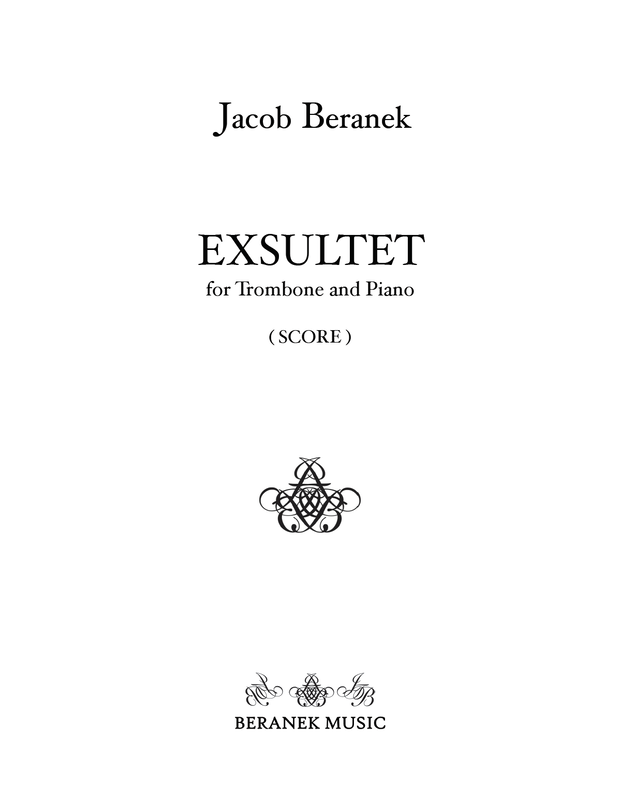Exsultet (2022)
trombone, piano
trombone, piano
Score & Part (digital download): $18.00
Score Only (digital download): $14.00 Score & Part (hard copy): $30.00 + shipping Score Only (hard copy): $22.00 + shipping |
Program Note
Perhaps the most significant day in the Christian faith is Easter, the celebration of Jesus Christ’s resurrection from the dead. Traditionally, this holy day—often referred to as Christ’s “victory”—is celebrated with a vigil the night before, which ends at midnight Easter morning. One of the central components of this vigil is an ancient chant called the Præconium Paschale (Easter Proclamation), which originated sometime between the 5th–7th Centuries. This historic proclamation is still sung today in many Christian churches and is often referred to simply by the first word in its Latin text: Exsultet (“exult!”). The first stanza announces:
Now let the angelic host of heaven exult:
Exult the mysteries divine:
And for the victory of so great a King, sound the trumpet of salvation.
Not having been raised in a church where this chant was sung, I was astonished by its triumphal imagery when I first read it in March 2022, and I instantly set to work on this piece. Naturally, the first event that had to occur musically was the “victory” that incited all of the celebration: rumbling low piano trills, thundering chords, and an earth-shaking fanfare sound repeatedly, as if reverberating in the celestial realms. From its first note, the trombone introduces fragments of the Exsultet chant, which is later presented more clearly in the middle section of the piece. The piano simultaneously provides a three-chord progression which recurs throughout the work. Then, the ecstatic joy of the “angelic host of heaven” erupts: what sort of sounds might angels make, flying around, engrossed in their heavenly festivities? The trombone presents two joyous melodies that are passed back and forth to the piano in canons amidst flourishes and runs. Eventually, the three chords burst forth again from the piano, interrupting the celebration, prompting a reflection from the trombone, which leads to the reverent, mysterious middle section. Here the trombone “sings” the beginning of the Exsultet chant and eventually elaborates upon it in a cadenza. (A recurring gesture here, too, is three repeated notes followed by a downward leap of a minor third. In the procession at the beginning of the Easter vigil, the priest always intones the words “Lumen Christi,” light of Christ, to these pitches.) Finally, the angels resume their celestial celebration, and a reprise of the opening fanfare leads directly into an animated coda which rounds out the work.
—Jacob Beranek
Perhaps the most significant day in the Christian faith is Easter, the celebration of Jesus Christ’s resurrection from the dead. Traditionally, this holy day—often referred to as Christ’s “victory”—is celebrated with a vigil the night before, which ends at midnight Easter morning. One of the central components of this vigil is an ancient chant called the Præconium Paschale (Easter Proclamation), which originated sometime between the 5th–7th Centuries. This historic proclamation is still sung today in many Christian churches and is often referred to simply by the first word in its Latin text: Exsultet (“exult!”). The first stanza announces:
Now let the angelic host of heaven exult:
Exult the mysteries divine:
And for the victory of so great a King, sound the trumpet of salvation.
Not having been raised in a church where this chant was sung, I was astonished by its triumphal imagery when I first read it in March 2022, and I instantly set to work on this piece. Naturally, the first event that had to occur musically was the “victory” that incited all of the celebration: rumbling low piano trills, thundering chords, and an earth-shaking fanfare sound repeatedly, as if reverberating in the celestial realms. From its first note, the trombone introduces fragments of the Exsultet chant, which is later presented more clearly in the middle section of the piece. The piano simultaneously provides a three-chord progression which recurs throughout the work. Then, the ecstatic joy of the “angelic host of heaven” erupts: what sort of sounds might angels make, flying around, engrossed in their heavenly festivities? The trombone presents two joyous melodies that are passed back and forth to the piano in canons amidst flourishes and runs. Eventually, the three chords burst forth again from the piano, interrupting the celebration, prompting a reflection from the trombone, which leads to the reverent, mysterious middle section. Here the trombone “sings” the beginning of the Exsultet chant and eventually elaborates upon it in a cadenza. (A recurring gesture here, too, is three repeated notes followed by a downward leap of a minor third. In the procession at the beginning of the Easter vigil, the priest always intones the words “Lumen Christi,” light of Christ, to these pitches.) Finally, the angels resume their celestial celebration, and a reprise of the opening fanfare leads directly into an animated coda which rounds out the work.
—Jacob Beranek


